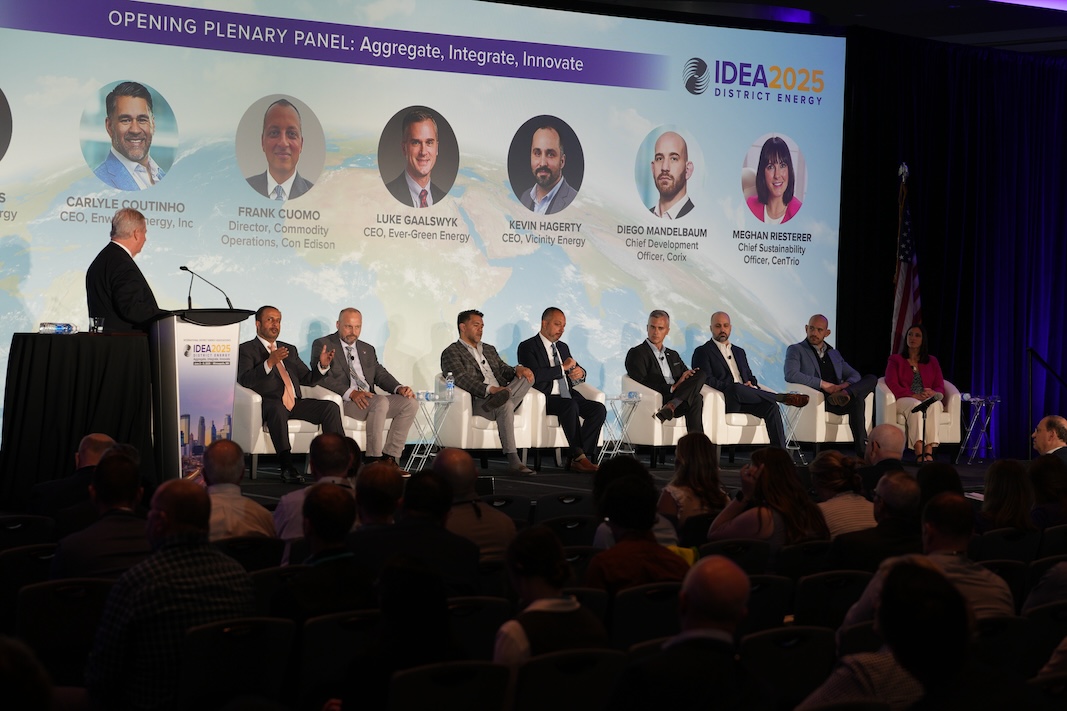Aggregate. Integrate. Innovate. 3 Takeaways from IDEA2025

This summer, the International District Energy Association’s 2025 Annual Conference gathered the brightest minds in energy, infrastructure, and technology to explore how we can build resilient, efficient, and sustainable cities. With the theme “Aggregate, Integrate, Innovate,” this year’s event showcased global innovation, local solutions, and practical steps for future-proofing energy systems. From rethinking data center design to electrifying urban cooling, here are the most powerful insights from the week.
Turning Waste Heat Into a Resource
The event kicked off with one of the most buzzworthy sessions. In the Data Center Workshop, panelists, Dale Medearis, Senior Regional Planner at Northern Virginia Regional Commission and Noah Nkonge, Heat Export Lead at Equinix discussed how to repurpose waste heat from data centers through District Energy (DE) systems to heat nearby communities.
With 360 data centers projected in Northern Virginia by 2035, energy demand and the opportunity for waste heat recovery is massive. But, more importantly, the technology is already there to make it happen. Nknoge spotlighted five existing data center heat export projects that could heat up to 10,000 homes. So what’s standing in the way of making this more prevalent nationally?
“To make data center heat export viable in the U.S., we need to educate policymakers, incentivize innovation, and rethink zoning,” Nkonge said.
The key takeaways:
- Require new data centers to evaluate heat export feasibility
- Mandate energy use reporting, as seen in the EU
- Zone new data centers near potential heat users, not in isolated areas.
Making Smarter, Stronger, More Integrated District Energy Systems
As electrification accelerates and stress on the grid grows, DE systems are proving vital in improving energy resilience. In the fall of 2024, Vicinity Energy unveiled its 42MW electric boiler in Boston and it’s already relieving pressure on the grid. CenTrio’s Chicago cooling system, the largest in the U.S., serves over 120 buildings and uses thermal storage to shed 15 MW of peak load. Ever-Green Energy in St. Paul is also integrating new technologies like geoexchange and heat pumps into its legacy system that now serves over 200 buildings with low-carbon heating.
Throughout the conference, the message was clear: This isn’t your grandmother’s steam system. DE systems today are adaptive, connected, and built for a secure, resilient energy future.
So how can we continue to integrate new sustainable energy sources into DE heating and cooling infrastructure:
- Coordinate with utilities to avoid substation overload and leverage sector coupling which is the integration and interconnection of different energy sectors (like electricity, heating, cooling, and transportation) to create a more efficient and sustainable energy system
- Take advantage of new technologies like electric boilers, thermal storage, nuclear and geoexchange that provide firm power
- Leverage local natural resources – many DE systems already incorporate river and lake water for sustainable cooling then return the water to the ecosystem cleaner and healthier
Scaling Clean Energy Through Collaboration
District Energy thrives when built at scale — aggregating both demand and innovative thinking. During the plenary panels, leaders emphasized the importance of strategic partnerships, streamlined regulations, and public education to unlock DE’s full potential.
“Before we integrate pipes and pumps, we need to integrate people, partners, and purpose,” said Diego Mandelbaum of Corix.
DE simplifies urban electrification by reducing peak loads, minimizing infrastructure duplication, and delivering economies of scale. From small modular nuclear reactors (SMRs) to AI-managed loads, the sector is evolving rapidly. Yet, as several panelists noted, technology alone isn’t enough.
To bring projects to life, energy leaders must understand and communicate the business, policy, and financial value of DE. This includes articulating how systems support economic development, comply with climate mandates, and deliver long-term savings. Dubai is a striking example of this strategy in action. Seventy percent of the city’s electricity use goes to cooling, and district cooling has become essential to shaping its skyline and its economy — all increasingly powered by clean energy.
What's Next: Innovation, Resilience, and Future-Proofing Energy Infrastructure
IDEA2025 made one thing clear: the energy infrastructure we relied on for the last 50 years needs to evolve. With bold collaboration, better policy, and smarter investment, we can build energy systems that are resilient, flexible, and future-ready.
If you're in the energy, planning, or sustainability space, now is the time to get involved. Find a mentor, join IDEA and other similar organizations and be part of shaping what comes next.
What our clients say

Integrated Marketing
Content Development
Public Relations
Brand Strategy
Integrated Marketing
Content Development
Public Relations
Brand Strategy
Public Relations
Brand Strategy
Integrated Marketing
Content Development
Public Relations
Brand Strategy
Integrated Marketing
Content Development
Let's start a project together.


